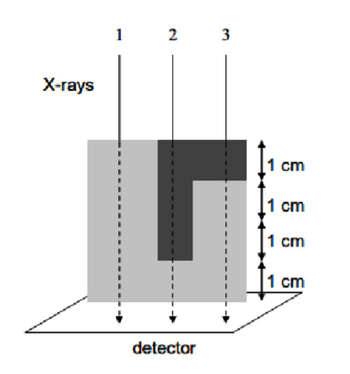Text book problem 2.9 In the figure below calculate the X-ray intensity, as a function of the incident intensity lo, that reaches the detector for each of the three X-ray beams. The dark-shaded area represents bone, and the light-shaded area represents tissue. The linear attenuation coefficients at the effective X-ray energy of 68 keV are 10 cm-¹ and 1cm-¹ for bone and tissue, respectively. X-rays 1 2 detector 3 1 cm 1 cm 1 cm 1 cm
Text book problem 2.9 In the figure below calculate the X-ray intensity, as a function of the incident intensity lo, that reaches the detector for each of the three X-ray beams. The dark-shaded area represents bone, and the light-shaded area represents tissue. The linear attenuation coefficients at the effective X-ray energy of 68 keV are 10 cm-¹ and 1cm-¹ for bone and tissue, respectively. X-rays 1 2 detector 3 1 cm 1 cm 1 cm 1 cm
Oh no! Our experts couldn't answer your question.
Don't worry! We won't leave you hanging. Plus, we're giving you back one question for the inconvenience.
Submit your question and receive a step-by-step explanation from our experts in as fast as 30 minutes.
You have no more questions left.
Message from our expert:
Your Radiology question does not match the subject you selected. Please ask a question in one of the 30+ subjects available. We've credited a question to your account.
Your Question:

Transcribed Image Text:Text book problem 2.9
In the figure below calculate the X-ray intensity, as
a function of the incident intensity lo, that reaches the detector for each of the
three X-ray beams. The dark-shaded area represents bone, and the light-shaded
area represents tissue. The linear attenuation coefficients at the effective X-ray
energy of 68 keV are 10 cm-¹ and 1cm-¹ for bone and tissue, respectively.

Transcribed Image Text:X-rays
1
2
detector
3
1 cm
1 cm
1 cm
1 cm
